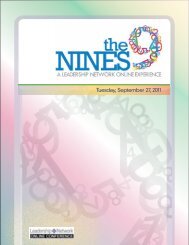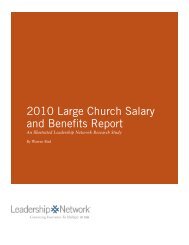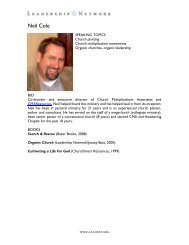ARE WE A PEOPLE AT HALF TIME? - Leadership Network
ARE WE A PEOPLE AT HALF TIME? - Leadership Network
ARE WE A PEOPLE AT HALF TIME? - Leadership Network
You also want an ePaper? Increase the reach of your titles
YUMPU automatically turns print PDFs into web optimized ePapers that Google loves.
changing anything, and the danger that each<br />
group will be focused only on its own function.<br />
It will do its job well, but pay little attention<br />
to the organization’s overall performance.<br />
Another team is exemplified by the way service<br />
to customers is now being organized. The<br />
service person assigned to the customer has<br />
the ball, in football parlance. The service person<br />
can and does call on anyone in the company<br />
to help a customer with a particular<br />
problem; that expert is then on the service<br />
person’s team for as long as it takes to fix the<br />
problem.<br />
Volunteers…need,<br />
above all, challenge.<br />
They need to know the<br />
organization’s mission<br />
and to believe in it.<br />
They need continuous<br />
training. They need to<br />
see results.<br />
And there are many, many more kinds of<br />
teams. We are now only beginning to explore<br />
them and to define the strengths and weaknesses<br />
of each and where each works or<br />
doesn’t work. But unless we work out—and<br />
fast—what a given team is suited for, and<br />
what a given team is not suited for, teams will<br />
become discredited as just another fad.<br />
What in all this is the role of the chief executive<br />
I doubt that anyone would assert that we<br />
really know how to organize the top management<br />
job, whether in a business, a university,<br />
a hospital or even a modern church. We talk<br />
incessantly about teams—and every study<br />
comes to the conclusion that the top management<br />
job requires a team. But here, rhetoric<br />
parts entirely from reality, and we practice the<br />
most extreme personality cult of supermen<br />
chief executives—Bill Gates, Jack Welch, Lou<br />
Gerstner—celebrities all.<br />
But how were these people selected and who<br />
will succeed them—and by what process<br />
What are the safeguards to assure that the<br />
successor will be the best person for the job<br />
People pay little attention to the succession<br />
process, though it is, in fact, the ultimate test<br />
of good management.<br />
Only One Way<br />
That one way or another people need to be<br />
managed remains the prevailing view, but it is<br />
wrong. On this fundamentally wrong<br />
assumption that there is only one right way to<br />
manage people rest all the other assumptions<br />
about people in organizations and their<br />
management.<br />
One of these assumptions is that the people<br />
who work for an organization are working<br />
full-time and are dependent on the organization<br />
for their livelihood. Another such<br />
assumption is that the people who work for<br />
an organization are subordinates expected to<br />
do what they are assigned to do and not much<br />
else.<br />
A very large and steadily growing minority of<br />
the work force are no longer full-time<br />
employees. They work for an outsourcing<br />
contractor, be it a cleaning service or a data<br />
processing outfit. Even if employed full-time,<br />
fewer and fewer people are subordinates,<br />
even in fairly low-level jobs. Increasingly they<br />
are knowledge workers. Knowledge workers<br />
cannot be managed as subordinates; they are<br />
associates. They are seniors or juniors but not<br />
superiors and subordinates.<br />
This difference is more than cosmetic. Once<br />
beyond the apprentice stage, knowledge<br />
workers must know more about their jobs<br />
than their bosses do, or what good are they<br />
The very definition of a knowledge worker is<br />
one who knows more about his or her job<br />
than anybody else in the organization. An<br />
executive, therefore, is not just being polite<br />
when he or she refers to an employee as an<br />
“associate.” The executive is simply recognizing<br />
reality.<br />
Their relationship, in other words, is far more<br />
like that between the conductor of an orchestra<br />
and the people who play the instruments.<br />
The conductor may not even know how to<br />
play a violin, yet the success of his conducting<br />
depends upon the quality of his associates.<br />
And just as an orchestra can sabotage even<br />
the ablest conductor—especially even the<br />
most autocratic—a knowledge organization<br />
can easily sabotage even the ablest, especially<br />
the most autocratic, superior.<br />
What this means is that even full-time<br />
employees have to be managed as if they were<br />
volunteers. In this, the typical corporation can<br />
learn a lot from the Salvation Army or the<br />
Catholic church.<br />
Like volunteers who work for the church and<br />
for the army, knowledge workers own their<br />
0<br />
3<br />
means of production, which is their knowledge.<br />
Furthermore, we have known for 50<br />
years that money alone does not motivate<br />
employees to perform much more than it<br />
motivates volunteers.<br />
What motivates—especially knowledge workers—is<br />
what motivates volunteers. Volunteers,<br />
we know, have to get more satisfaction from<br />
their work than paid employees precisely<br />
because they do not get a paycheck. They<br />
need, above all, challenge. They need to know<br />
the organization’s mission and to believe in it.<br />
They need continuous training. They need to<br />
see results.<br />
One does not “manage” people, as previously<br />
assumed. One leads them. The way one maximizes<br />
their performance is by capitalizing on<br />
their strengths and their knowledge rather<br />
than trying to force them into molds.<br />
The Erasing of Technological<br />
Boundaries<br />
In the 19th century and throughout the first<br />
half of the 20th, it could be taken for granted<br />
that technologies outside one’s own industry<br />
had minimal impact on that industry. Know<br />
your own technology and you prospered.<br />
Now the assumption to start with is that the<br />
technologies likely to have the greatest impact<br />
on a company and its industry are technologies<br />
outside of its own field. Technologies,<br />
unlike the 19th century technologies, no<br />
longer run on parallel but separate tracks;<br />
they constantly crisscross.<br />
As they crisscross, the walls that neatly defined<br />
industries have come tumbling down. Where<br />
once companies competed within an industry,<br />
today industries compete with industries. The<br />
same is happening in services. All those “natural”<br />
monopolies have faded away.<br />
One implication of this is that non-customers<br />
are as important as customers, if not more<br />
important, because they are potential customers.<br />
There are very few institutions where<br />
the non-customers do not amount to at least<br />
70% of the potential market. And yet very few<br />
institutions know anything about the non-customers—very<br />
few of them even know that<br />
they exist, let alone know who they are. And<br />
even fewer know why they are not customers.<br />
Yet it is with the non-customers that changes<br />
always start.<br />
All our experience tells us that the customer<br />
never buys what the supplier sells. Value to<br />
the customer is always something fundamentally<br />
different from what is value or quality to<br />
the supplier.<br />
www.leadnet.org







